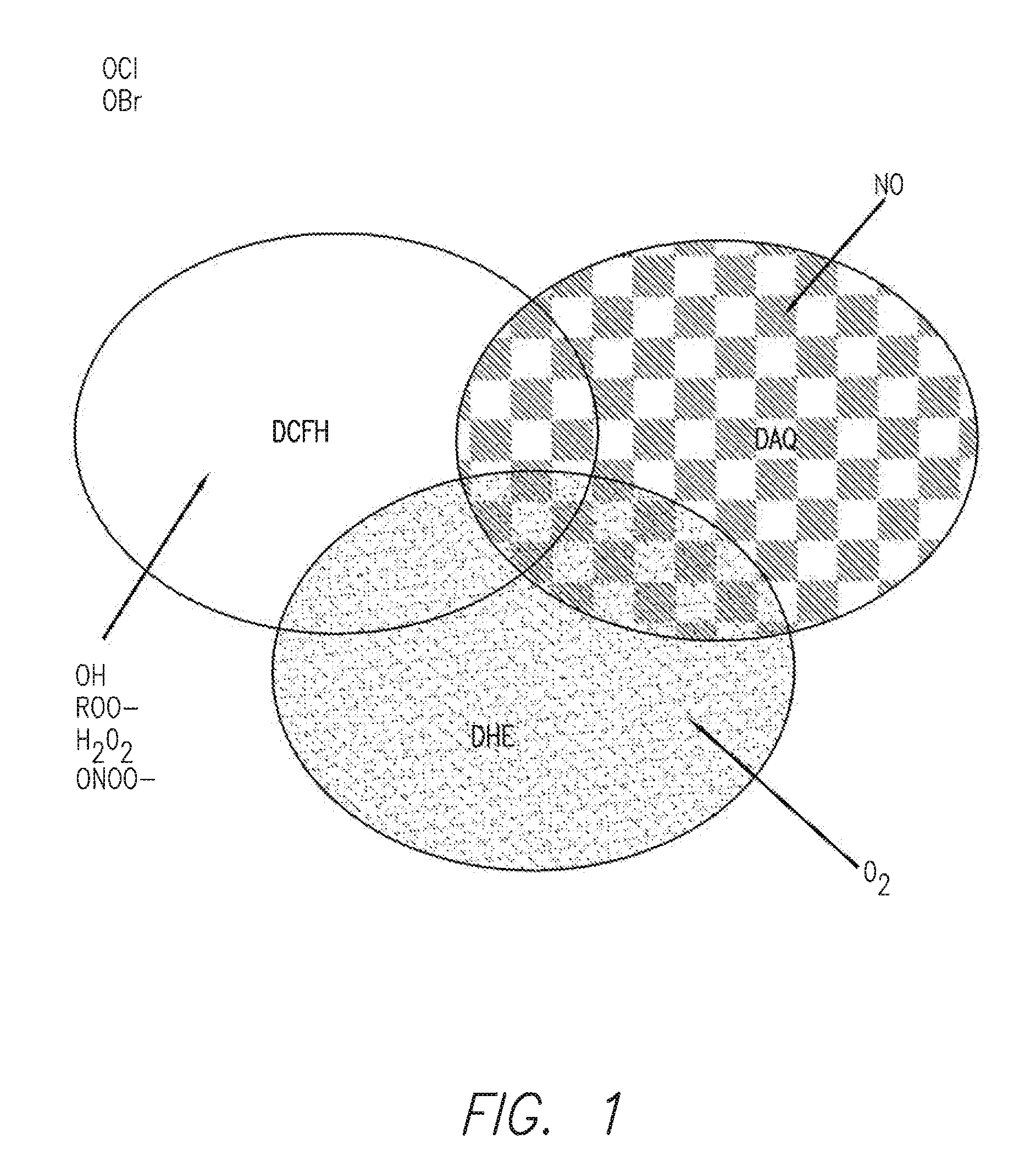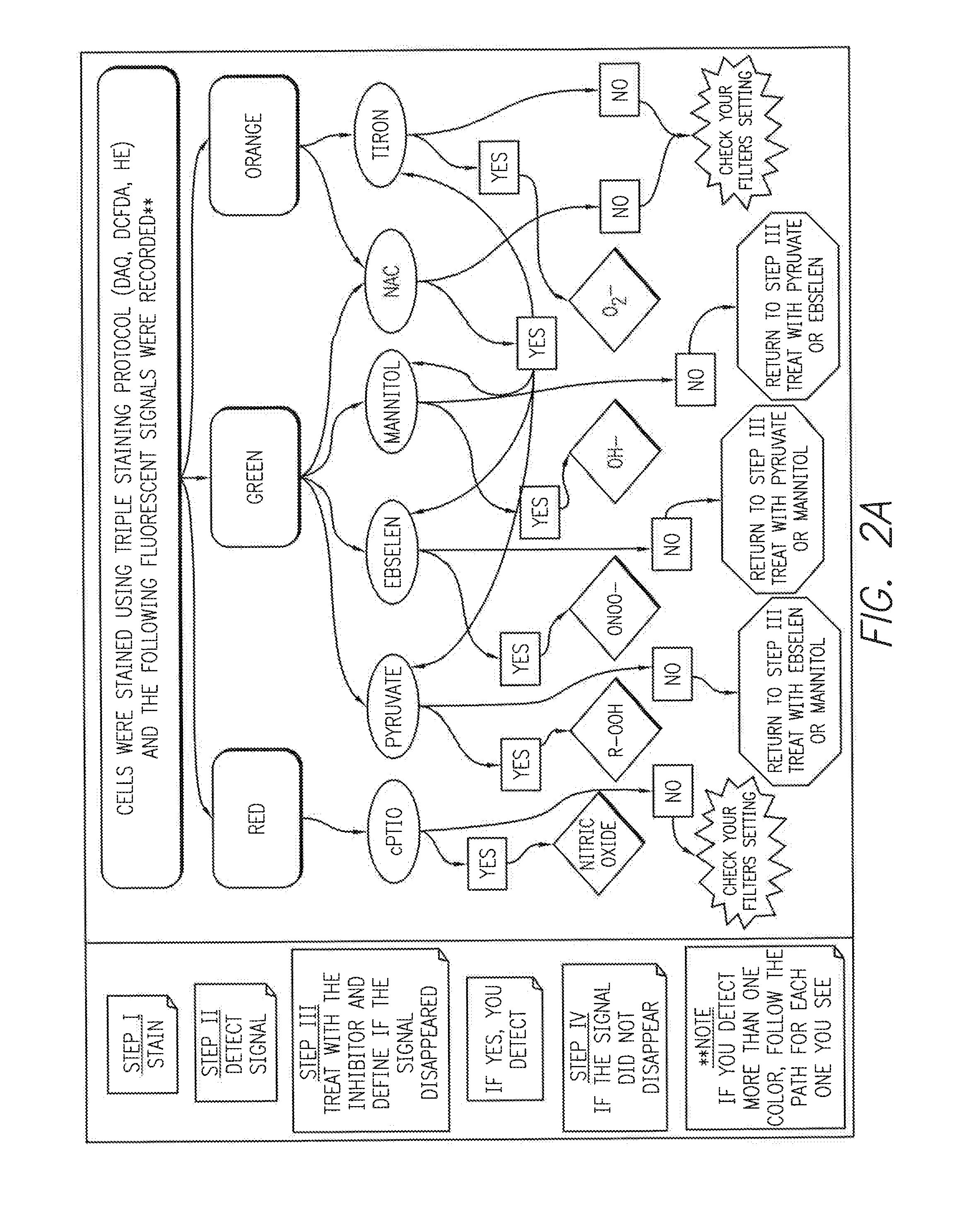Profiling reactive oxygen, nitrogen and halogen species
a technology of reactive oxygen and nitrogen, applied in the field of free radicals and reactive species, can solve the problems of limited scope of efforts to develop such organic fluorescent probes for ros/rns profiling, and the inability to offer single fluorescent probes, and achieve the effect of increasing or reducing the production of ros/rns
- Summary
- Abstract
- Description
- Claims
- Application Information
AI Technical Summary
Benefits of technology
Problems solved by technology
Method used
Image
Examples
example 1
Detection of ROS / RNS Production in HeLa Cells by Wide-Field Fluorescence Microscopy Using a Triple-Staining Protocol
[0109]Human cervical adenocarcinoma epithelial cell line HeLa was obtained from ATCC (ATTC, Manassas, Va.) and was routinely cultured in Dulbecco's modified eagle medium with low glucose (Sigma-Aldrich, St. Louis, Mo.), supplemented with 10% fetal bovine serum heat inactivated (ATCC) and 100 U / ml penicillin, 100 μl / ml streptomycin (Sigma). Cell cultures were maintained in an incubator at 37° C., with 5% CO2 atmosphere. Three ROS / RNS fluorescent probes were dissolved in anhydrous DMF at the following concentrations: DAQ-20 mM (a 400× stock solution), DCFDA-5 mM (a 5000× stock solutions), DHE-5 mM (a 5000× stock solution). Anhydrous organic solvents should be used with DMF being the first choice, since DMSO is a hydroxyl radical scavenger and its presence may affect ROS / RNS production in cellular systems. Stock solutions of the dyes were aliquoted and stored at −20° C. T...
example 2
Specific Profiling of ROS / RNS Induced in HeLa Cells by Different ROS Inducers Using Wide-Field Fluorescent Microscopy
[0114]For purposes of simplifying the assay description, this example was carried out with only two indicator probes, though analogous procedures were employed as in the case where three fluorophores were utilized. Human cervical carcinoma cell line HeLa was cultured as described in Example 1. The day before the experiment, the cells were seeded in multi-well microscope slides (Gel-Line™, Portsmouth, N.H.) at a density of 2×104 cells per well. On the next day, the cells were treated with different ROS inducers (0.1 mM tert-butyl hydroperoxide [TBHP], 0.1 mM pyocyanin or 0.1 mM pyrogallol) for 1 h at 37° C. After a brief wash with PBS, the cells were stained with 1 l-1M of DGFDA and HE in culture medium for 30 min, 37° C., washed twice with PBS, overlaid with a cover slip and observed under the fluorescent microscope, using green and orange filters described in the Tab...
example 3
Monitoring Kinetic Changes in Levels of NO and ROS in HeLa Cells by Wide-Field Fluorescence Microscopy
[0118]HeLa cells were cultured and plated as described in Example 1. On the day of the experiment, cells were loaded with 50 μM of DAQ, 1 l-1M of DCFDA and HE for 2 h, 37° C. and induced with different ROS and NO inducers (1 μM of A23187, 0.2 mM of antimycin A, 1 mM of L-arginine, 0.1 mM of pyocyanin or combination of L-arginine and pyocyanin) at 37° C. Samples for fluorescent microscopy were prepared after 10, 20, 30, 45 and 60 min of treatment as described in Example 1 and analyzed using an Olympus wide field fluorescent microscope (set of filters as described in the Table 2).
[0119]Data presented in FIG. 5, demonstrated that the developed protocol allowed real-time detection of changes in NO levels (Panel A), total ROS / RNS levels (Panel B) and in the levels of superoxide production (Panel C). L-arginine treatment quickly induced nitric oxide synthase (NOS) in HeLa cells resulting ...
PUM
| Property | Measurement | Unit |
|---|---|---|
| oxidative stress | aaaaa | aaaaa |
| nitrative stress | aaaaa | aaaaa |
| halogenating stress | aaaaa | aaaaa |
Abstract
Description
Claims
Application Information
 Login to View More
Login to View More - R&D
- Intellectual Property
- Life Sciences
- Materials
- Tech Scout
- Unparalleled Data Quality
- Higher Quality Content
- 60% Fewer Hallucinations
Browse by: Latest US Patents, China's latest patents, Technical Efficacy Thesaurus, Application Domain, Technology Topic, Popular Technical Reports.
© 2025 PatSnap. All rights reserved.Legal|Privacy policy|Modern Slavery Act Transparency Statement|Sitemap|About US| Contact US: help@patsnap.com



